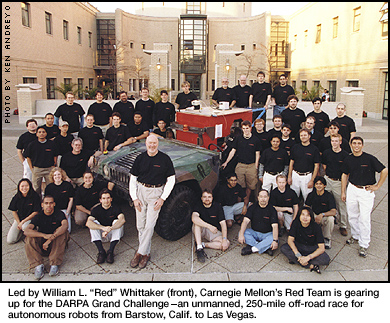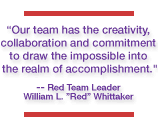|
|
||
|
|
|
 Red Team Preparing for $1 Million Robotics Race Across the Desert� � Carnegie Mellon's Red Team, directed by Fredkin Research Professor William L. "Red" Whittaker, will compete in the Defense Advanced Research Projects Agency (DARPA) Grand Challenge, an unmanned, off-road race for autonomous robots from Barstow, Calif., to Las Vegas, on March 13, 2004. The winning team will earn a cash prize of $1 million. � Whittaker, a pioneer developer of mobile robots for hazardous environments, is collaborating with students in his Mobile Robot Development Class, colleagues and a host of corporate sponsors to build an autonomous vehicle that will travel 250 tortuous miles through the Mojave Desert on its own. Competing teams will learn the exact route of the race only two hours before race time. Once the race begins, no human intervention is allowed. The robots must sense, plan and make the strategic decisions necessary to drive the course in a 10-hour time limit. The team whose robot finishes first in the allotted time will receive the $1 million prize. If there is no winner, the race will be held again in future years. "The Red Team is racing to catalyze technology, build new relationships, change the view of what's possible and create new robotic applications in the world," Whittaker said. "This great challenge will revolutionize robotics and improve the quality of life for humankind." Experts say it will take huge leaps of technology to win the challenge. Sensing must improve immensely in terms of range, speed and accuracy. The distance of autonomous driving must be stretched from miles to hundreds of miles and duration must be reduced from days to hours. This will require unprecedented advances in hardware and software for mobile robots.
"The technical difficulties are enormous, similar to those experienced by the Wright Brothers, but not beyond our grasp. Our goal is to succeed with technology, program and the best team in the race," Whittaker said. Whittaker's students on the Red Team have joined volunteers and experts from more than a dozen sponsors. The students bring expertise in engineering, computing, art and robotics. Sponsors, including Applanix Corp., The Boeing Co., Carnegie Mellon, Caterpillar, Inc., CM Labs, HD Systems, Inc., Intel Corp., The Lord Corp., Mechron Power Systems, Omnistar, Robotics Foundry, Science Applications International Corp. (SAIC), Seagate Technologies, Inc. and TerraSim, Inc. are contributing technologies, components, software and assistance. Chip Ganassi Racing, Rod Millen Motorsports and Team Rod Hall Hummer are counseling on the art and science of off-road racing. � All are working to pull together the mechanics, electronics and software that will give their diesel-powered Humvee, named "Sandstorm," the guts and smarts to win the race. The Red Team is applying technologies developed by its members over decades. One example is a planning algorithm developed at Carnegie Mellon that has been used successfully in more than a dozen outdoor robots. The algorithm will guide the robot around large terrain features and stitch together routes connecting the waypoints that will describe the route to the contestants on race day. Other critical elements are premapping and preplanning strategies. Red Team technology leader Chris Urmson describes them as "enabling capabilities for competing in the race. We'll be using 1.5 terabytes of data to generate high-resolution maps of the desert," he said. "Our planning software will process the maps to classify the terrain, reach the waypoints, avoid difficulties, determine our speeds and optimize our route."
"We need to have excellent sensing capability, more than has ever been accomplished before for computer modeling of the complex terrain expected in the race," Urmson said. The team is building a stabilization device to ensure that important sensors remain steady and pointed in the right direction. This past October, Red Team members traveled into the Mojave to field–test some of the technologies they've been developing. Starting in January 2004, 10 team members will work from the desert for the two-and-a-half months leading up to the race, testing systems and improving their reliability. "We're doing something that's never been done before," Whittaker said. "We have an absolute time line and a clear criterion for success. Our team has the creativity, collaboration and commitment to draw the impossible into the realm of accomplishment." �
Anne Watzman� � � � �
�
Top�
�
|
|
This Issue's Headlines || Carnegie Mellon News Home || Carnegie Mellon Home |
||

 The team is adding actuators for steering, throttle and brakes so that the navigation computer can physically operate the vehicle. Chassis suspension is being modified to soften the ride, since computer driving will be rough because it will encounter hazards a human might avoid. Because some of the cutting-edge components are fragile, the team is further cushioning the ride above the chassis to protect them.
The team is adding actuators for steering, throttle and brakes so that the navigation computer can physically operate the vehicle. Chassis suspension is being modified to soften the ride, since computer driving will be rough because it will encounter hazards a human might avoid. Because some of the cutting-edge components are fragile, the team is further cushioning the ride above the chassis to protect them.